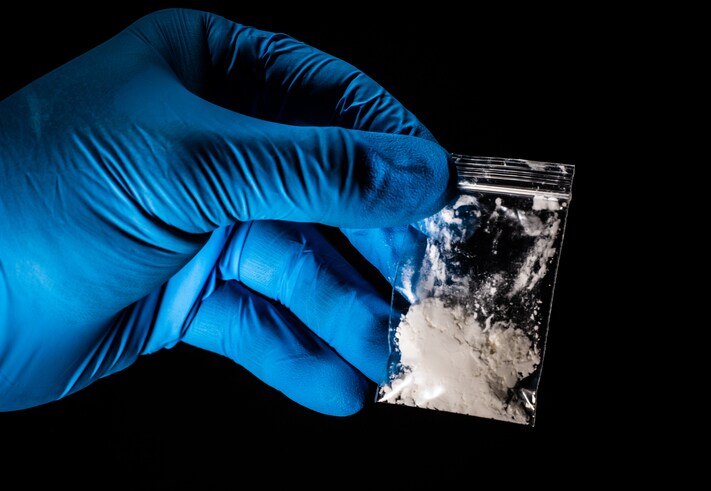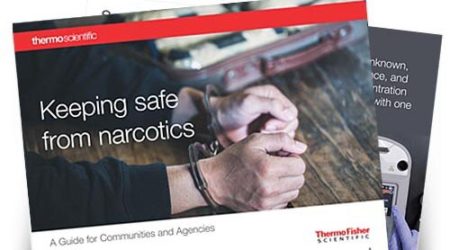 After Chico, California, first responders administered Narcan to unconscious housemates and transported the overdose victims to the hospital, it was reported by a local news station and confirmed by the local Narcotics Task Force that the substance that was found on the floor with the victims contained fentanyl; and a total of 2.7 gross grams of the substance were seized.
After Chico, California, first responders administered Narcan to unconscious housemates and transported the overdose victims to the hospital, it was reported by a local news station and confirmed by the local Narcotics Task Force that the substance that was found on the floor with the victims contained fentanyl; and a total of 2.7 gross grams of the substance were seized.
The Task Force used a handheld narcotics analyzer— which utilizes a well-established analytical technique called Raman spectroscopy — to identify the substance. These handheld analyzers can identify key drugs of abuse as well as common cutting agents, precursors and other threats such as fentanyl, fentanyl compounds and analogs, as well as the fentanyl precursors, NPP and ANPP. The instruments offer a presumptive test that is more accurate and reliable than colorimetric drug tests, providing law enforcement officials a quicker method to identify suspected narcotics in the field. And, with these analyzers, law enforcement personnel can sample most substances through sealed packaging, increasing officer safety.
Tragically, three years ago this same month, there were news reports about another Chico drug incident where one person died and 12 people were hospitalized because of overdoses caused by ingestion of some form of fentanyl and other substances. In addition, “Two officers who responded to the scene also went to a hospital after they said they felt the effects of a drug similar to fentanyl…. Both officers were treated and released.”
Fentanyl is a potent synthetic opioid, abused for its intense euphoric effects. The Drug Enforcement Administration Diversion Control Division fact sheet on Fentanyl notes that the drug “can serve as a direct substitute for heroin in opioid dependent individuals. However, fentanyl is a very dangerous substitute for heroin because it is much more potent than heroin and results in frequent overdoses that can lead to respiratory depression and death.”
Law enforcement agencies and first responders are all too often finding this to be true in their own cities. Unfortunately, drug overdoses are meeting milestone numbers. In January, the CDC National Center for Health Statistics announced that drug overdose deaths in the U.S. would top 100,000 annually. According to the press release:
“Data from the National Center for Health Statistics indicate that drug overdose deaths in the United States have increased by 28.5% during 2020–2021, from 78,056 during a 12-month period ending in April 2020 to 100,306 during the same period in 2021. Approximately 75% of drug overdose deaths during 2020 involved opioids.”
Want to see the latest numbers? The CDC now offers an interactive web dashboard* that provides 12 month-ending provisional number of drug overdose deaths by drug or drug class. As of this writing, the latest figures offered for analysis were dated January 2, 2022, but reported up to June 2021. Deaths were predicted to reach 101,263 in the US – over 11,000 in California alone.
It’s not just California. The Knox County Regional Forensic Center (KCRFC) in Knoxville, Tennessee, reported 770 total unintentional drug overdose deaths for November 2020 to August 2021. “Among these deaths, 562 (73.0%) cases received postmortem positive test results for fentanyl, including 192 fentanyl-positive cases reported in the absence of other substances (i.e., fentanyl only), 188 that involved fentanyl and methamphetamine, 48 that involved para-fluorofentanyl, and 26 that involved metonitazene.”
There are stories like this all over the country. The global drug problem is increasing, with production and trafficking of common street fentanyl analogs including carfentanil, methamphetamines, cocaine, MDMA (ecstasy), heroin, and cathinones (bath salts) impacting communities worldwide and stressing already constrained investigative resources. Law enforcement personnel utilizing handheld narcotics analyzers to quickly identify suspected illegal drugs in the field and get clear, definitive results are just one way to help keep drugs, and drug dealers, off the streets, and the overdose rate from increasing.
Resources and References:
- Safer Narcotics Identification: A Guide for Communities and Agencies
- *Ahmad FB, Rossen LM, Sutton P. Provisional drug overdose death counts. National Center for Health Statistics. 2022.
- https://www.cdc.gov/mmwr/volumes/71/wr/mm7104a3.htm
- https://www.cdc.gov/nchs/nvss/vsrr/drug-overdose-data.htm


Leave a Reply